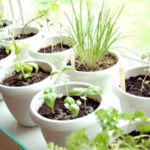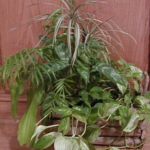Welcome Insects into Your Garden!
Update: Since this post was written, Jessica has a new book out: Attracting Beneficial Bugs to Your Garden, and Kathy Purdy, freelance garden writer and author of the great blog, Cold Climate Gardening, recently interviewed Walliser. Check out her informative post: What You Don’t Know About Bugs Could Make Your Garden Better.
Mention bugs to the average gardener and you’re likley to get a squeamish or alarmed response. The truth is that insects are a natural a vital part of our indoor and outdoor ecosystems, and in many cases, they’re a good thing to have on your houseplants.
In her book, Good Bug, Bad Bug: Who’s Who, What They Do, And How to Manage Them Organically, horticulturist Jessica Walliser introduces you to good and bad insects and encourages you to appreciate them. Printed on four-color, water-proof laminated pages, the book has pictures of pests and their damage, as well as the good guys. In simple terms, she explains how to get rid of common invasive pests in a non-toxic manner and how to encourage beneficials to come and stay.
Jessica took the time to answer a few questions about her book for HealthyHouseplants.com readers.
HHP: You mention in your book’s introduction that fewer than 10% of insects are what gardeners would consider harmful and that the remaining 90% are benign or beneficial, and that even the bad guys are beneficial in their own way. Please tell us more about this. Was this one of the reasons you wrote the book?
Walliser: Gardeners are often surprised to find out that so few insects are actually harmful to our plants, and that the majority of pest insects do indeed serve a purpose. Most of them are food for critters a little further up on the food chain (think of moles eating Japanese beetle grubs, birds eating cabbage worms, and shrews eating grasshoppers as a few examples of this); others may be pollinators during a different stage of their lifecycle (cabbage worm butterflies and tomato hornworm moths are two examples); and still others serve as decomposers, helping to break down waste matter into nutrients our soil and plants can use to flourish (think slugs and earwigs on this one). And, yes, this was one of the reasons I wrote the book. The insects living in our yards and gardens are often misunderstood and needlessly targeted as pests when in fact they are just going about their own business, trying to survive. That being said, some pests do indeed need to be controlled as they can really cause significant damage to our landscapes. This book was also written to help people determine which bugs are worth battling and which are better left alone. The ‘nuke em and leave’ philosophy when dealing with bugs is really outdated and gardeners want safer ways to deal with pests without harming the rest of the garden’s ecosystem.
HHP: How should gardeners use your book? It seems that using the book will give them a greater understanding of pests/beneficials in general. You have great photos of the pests and beneficials in the adult and larval stages, plus descriptions of their appearance and the damage or good they do.
Walliser: First and foremost, the book is meant as a type of field guide for gardeners. Use it to properly identify any critters you find so you can first determine if they are friend or foe. That’s why the pictures are so important, in particular the images of the damage. Many times gardeners see holes in leaves but not the pests themselves. Learning to recognize the distinctive damage that some insects cause is often just as important as learning to identify the pests themselves. After making a proper ID, use the book to find out what kind of beneficial predatory insects can be attracted to the garden to bring the pest populations in check (hence the pages dedicated to beneficials in the back) and then use it to find out other methods of pest control and prevention.
I also have heard from many gardeners who are using the book for another surprising reason: their kids. Apparently moms, dads, grams and gramps are giving the book to their kids and letting them loose in the yard and garden. For children interested in the insect world, they say that it’s a great teacher!
HHP: How does your book fit in with global warming?
Walliser: Insect ranges are shifting as a result of global climate change and gardeners are going to start encountering pests we’ve never seen before. An example here in Pennsylvania is the tobacco budworm which attacks the buds and flowers of flowering tobacco, geraniums and petunias. Ten years ago it was extremely rare to come across one of these in our gardens. Five years ago, we could find them here and there very late in the season. The adult moths are not winter hardy and would migrate northwards during the growing season. Now, I routinely find them in my garden toward the beginning of August. They are overwintering further north and, as the winters warm, their range is extending. This is happening across the country with a number of pest insects and, as a result, gardeners are going to have to educate themselves on proper insect ID and on techniques to manage brand new pests in their area.
HHP: It seems that many gardeners have a pest nemesis that follows them through their gardening career. Mine is the mealybug, which infested my first indoor garden when I was just eight years old. How about you? Any particular pest that has been peskier than the others for you?
Walliser: Sometimes I wonder what pest hasn’t followed me through my gardening career! When I had my perennial garden maintenance business years ago, it was sawfly larvae on roses and hollyhocks. At our organic farm, it was the squash bugs; and now, on our ‘new’ two acres, it seems that the Japanese beetles have found us and are hell-bent on consuming every last leaf on our new fruit trees.
HHP: Anything else you think is important to mention?
Walliser: Understanding the balance of pest insects and predatory beneficial ones is a very critical aspect of organic gardening. There will always be pests; and there always should be pests. For without them, the beneficials have no reason to stick around and lay eggs. Total elimination of any pest is not wise (nor is it possible!). The goal is to employ management strategies to develop a balance of good and bad insects in the garden. Learn to love your bugs (or, at the very least, appreciate them)!
HHP: How can readers get a copy of your book?
Walliser: Get an autographed copy on my website at http://www.jessicawalliser.com, or buy it through Amazon and other book retailers.





